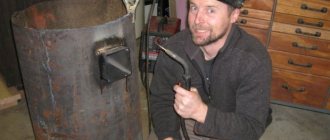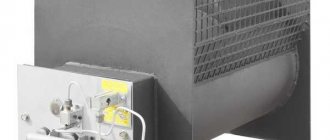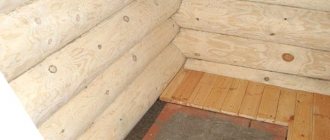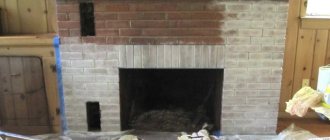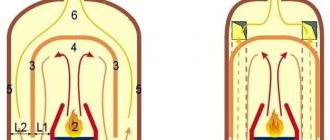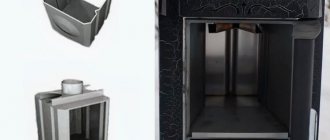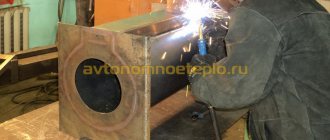The most thoughtful buyer of a sauna stove is a man slightly over 55. He confidently walks along the orderly rows of various stoves and with his gaze selects the mouth of the chimney with the thickest metal. Having discovered such an instance, he taps on it with his finger for a long time and subtly listens to the sound, like a cat to the movement of a mouse. Having “sipped” the stove with both hands, appreciating its fullness, he soon quickly left, shouting loudly at the sales assistant’s suggestions: “don’t teach me how to live.” Such people, as a rule, do not buy a stove at all, but order it from a neighbor in the garage who does welding work. For them, the thickness of the metal is sacred. Probably, products under the loud name Tsar-stoves would satisfy them, after all, a full-weight 8 mm firebox body, or even as much as 10, if you wait.
Design features and types of furnaces
The classic Russian bathhouse is close to many people and is very popular among owners of private houses and summer cottages. This is not only entertainment and relaxation, but also great health benefits. This is why so many people value it, trying to provide themselves with such an attribute in their own home.
Typically this design weighs about 800 kg. This makes preparation necessary for its installation. The foundation must be at least half a meter deep and 5 cm larger than the dimensions of the stove on each side. If an iron sauna stove of a simplified version is not so heavy, then a foundation is usually not needed. It can be installed on a concrete floor.
If the stove is wood-burning, you will need a grate. You can make it yourself or order a ready-made version in the store. The grate is set in height as the level of the firebox door itself. From the side of the fuel compartment, 30 cm from the door.
The outer wall is half the thickness of a brick. Inside the fuel chamber, the following trick is often used: they make bevels for the coal that has burned, so that it eventually ends up on the grate.
Any oven will still consist of the following main parts:
- Ash pan. This is the space under the firebox for collecting ash, which will need to be cleaned out periodically.
- This door is needed to allow air flow into the structure so that the fuel flares up better.
- Chimney damper. Needed to provide the required draft in the stove. When it is fully open, the fuel burns hotter and, accordingly, burns faster. When the wood burns out and coals remain, the valve is closed. which helps keep you warm. But this should be done after they have cooled down, when they stop burning. Otherwise, to avoid harm to health, leave a gap of about two cm to allow air to pass through.
- Boiler (coil). Here the water is heated, due to the steam of which the bathhouse “works”.
Each oven has its own characteristics. Types of ovens:
Wood-burning sauna stove. This is the most popular oven option. It consists of a firebox, chimney, ash pan and grate. Such stoves are made of metal or stone. They so often become the choice among bathhouse fans because they have advantages: even the small dimensions of the device can provide enough heat to warm up a large room. Such furnaces are used even when there is no gas supply at the site. This type of oven is the easiest to use. It also has a calming effect - the sound of crackling firewood.
Cast iron stove. They, in turn, are divided into temporary and permanent combustion furnaces. In the first case, firewood is used for the firebox. You can use the sauna when all the wood is burned. For a continuous combustion furnace, liquid fuel or gas is used as fuel. In the second option, the steam room is suitable for use already when the stove is just being heated. This type of stove will warm up the rooms faster and distribute the steam more evenly throughout the entire area of the room.
Electric oven. It comes in different sizes, has different characteristics in terms of efficiency and power. Like the previous one, it heats up quickly and lasts a long time. The advantage is that an electric stove does not require a chimney. They are also not expensive.
Finnish sauna stove. They produce dry steam combined with high temperature. Such stoves come in both electric versions and those using wood as fuel. You can make such a stove with your own hands. All you need is special drawings and instructions.
In order to use the stove to its maximum, it is advisable to know some features. For example, a wood-burning sauna stove can also be heated with other solid fuels. Coal and briquettes are allowed. If you approach the task of making a stove for a bath correctly, it will serve for a long time and will delight you with its reliable operation.
a8036fda206dc9ae23b336cf6cd695a2.jpe
Cast iron stoves are connected to a central gas supply for operation. The use of gas cylinders for these purposes is not recommended due to the increased risk of explosion.
Stoves that use liquid for combustion emit a specific odor.
When choosing an electric furnace, it is better to check the wiring first. Such stoves are not very economical for large rooms, which is also worth considering.
The cost of assembling the stove itself will depend on many parameters, primarily its size.
Down with the savings
Armies of experts clashed to the death over the question of which sauna stove is better: a thin-walled lightweight one with a stainless steel firebox or a full-weight all-metal one made on the basis of structural steel. Both sides passionately present a lot of arguments, in which, of course, there is a rational grain. Whatever one may say, the world is devoid of perfection, and any product is not without drawbacks, with a lot of advantages and positive aspects. Let’s try to briefly, concisely, and essentially reflect the comparative characteristics of light and heavy class stoves. So, what is good about a thin-walled stainless steel stove:
- Lightweight, mobile, does not require any foundation for installation, except for taking fire safety measures;
- Due to the lower thermal conductivity of stainless steel, such a system is less susceptible to the manifestations of abundant radiation of infrared waves, especially if the firebox is separated from the external space by a convection casing, also made of stainless steel;
- Stainless steel, which is used in the external finishing of the stove, has good decorative qualities, in addition, the polished surface is well maintained and cleaned during periodic cleaning. The loss of attractive appearance for such furnaces is less important than for products made of ferrous metal.
Important! Thin-walled furnaces made from conventional structural steel are a very controversial phenomenon. With less intensive use, the firebox may burn out, the load-bearing capacity of the furnace roof may weaken as a result of systematic annealing of the metal and the progression of thermal corrosion. As a result, the heater basket may collapse, which will put an end to further operation. Defects such as the manifestation of fistulas, linear and radial deformations, and defragmentation of the grate may not even be mentioned.
Now let’s take the side of the advocates of the idea of a full-fledged heavy structure.
Give me metal
So, a full-scale oven is good for the following conditions:
- The large thickness of the metal eliminates the phenomenon of so-called “thermal clicks”, when, as a result of rapid heating, the metal is deformed with a characteristic sharp, jerky sound. By the way, such deformation may be residual, that is, the accepted spatial position of the firebox wall will remain so, as a result of which, in especially serious cases, repair and restoration work will have to be carried out by straightening the surfaces.
- The large mass of the furnace implies increased heat capacity, which is very important. We know that structural steel has high thermal conductivity, but a low heat capacity coefficient, which does not correspond very well with the concept of a “correct” bath.
- The thickness of the furnace roof of 8 mm or more, to some extent, alleviates the problem of thermal corrosion with the active formation of oxides.
- The high strength of thick-walled structures allows them to be painlessly tied with various additional devices, such as: baskets for stone backfill with increased capacity, overhead water tanks and chimney tanks - samovars.
How does the king of the sauna stove behave in this situation? Let's get a look.
Types of stoves
The unit must efficiently heat the entire steam room, but not interfere with or pose a danger to visitors
It is worth paying attention to the design of the stove that you plan to install in the steam room. If we classify products according to the location of the fuel door, we can distinguish the following options:
- The firebox door opens directly from the steam room. This option is the most common. Firewood is loaded from the steam room. It is very convenient to adjust the draft by opening the door slightly. If the door is equipped with tempered glass, then the opportunity to admire the flames while vaping is added. However, it is worth remembering that when loading firewood, dirt remains on the floor, and oxygen in a small room is burned out too quickly;
- the firebox door opens into the dressing room or rest room. Fuel is loaded from the same room. This option is considered the best and safer, because the oxygen in the steam room is not burned out by the flame, it is easier to maintain cleanliness, space in the steam room is saved, and it is not necessary to install a separate heating system in the relaxation room. If, during the construction of the walls, a technological hole for an extended (remote) fuel channel was not provided in advance, then the partition will have to be partially broken;
- The firebox door faces the street. Perhaps an acceptable option only for the smallest baths or baths with seasonal use. Loading and reloading fuel and traction control will have to be done by constantly running outside, which will cause discomfort.
The furnaces themselves, by their design, can be vertical, horizontal, in the form of a barrel and other shapes. There may be a grid for stones and a hot water tank. Chimneys from metal stoves are discharged through the ceiling or wall.
Metal wood-burning stoves for saunas
Conclusion
In the video presented in this article you will find additional information on this topic. Also, based on the text presented above, we can conclude that the principle of making metal stoves is quite simple. At the same time, there are a lot of different designs that have their own specific features and characteristics (see also the article “Drawings of a metal stove for a bath with your own hands: how to build a heater in a steam room with high efficiency”).
Special attention should be paid to some factory products, which are presented in the form of doors, chimneys and grilles. They will significantly simplify the manufacturing process, which means it is worth developing drawings on their basis.
Did you like the article? Subscribe to our Yandex.Zen channel
Long-burning boiler principle
Before reviewing the unit, you need to understand the principle of its operation. The bubafonya stove runs on solid fuel - wood. Before you start burning it, you need to prepare the wood. In the boiler it is heated to 250 degrees Celsius using paper ignition.
When charring, wood decomposes into simple chemicals: gases and vapors. When the temperature reaches 300o Celsius, the gaseous components ignite, accelerating the thermal reaction.
To protect against fire, and also to prevent it from spreading throughout the entire container, a protective screen is provided on the fireplace. A damper is used to regulate the temperature. When turned off, the air supply stops, as does the combustion process.
e73a5161b278f1b9b6cce9d093acdbd7.jpe b91f0cbcde1d75943e45664645a35bcc.jpe c66866520f2ead98723282e8dfc82f03.jpe c3e999ec2fa9779517be1a04935 82877.jpe
One, two and done
Currently, there are drawings of potbelly stoves with round and rectangular sections. The figure shows a diagram according to which a potbelly stove can be made with your own hands from an ordinary milk can; a similar design can be made from a metal barrel.
Potbelly stove from a can
In order to make a potbelly stove like this for a summer house or garage with your own hands, you will need a minimum of tools and materials:
- An old milk can (if you chose the option of making it from a barrel, then the barrel is made of metal);
- Metal rod with a diameter of 6 mm;
- Retraction. If you have the skill, you can make it yourself;
- Hammer;
- Chisel;
- File.
You can start working with your own hands. We specifically did not indicate the dimensions so that the master would base it on the diameter of the barrel or can used.
First you need to make a blower. To do this, a rectangular hole is cut below the neck of the can (barrel). The edges of the hole are processed with a file.
After this, it is necessary to cut a hole in the bottom of the can (barrel) of such a diameter that you can subsequently insert the outlet tightly (see the article Chimney for a potbelly stove). This is done as follows:
- At the site of the future chimney, markings are made at the bottom of the can or barrel. The diameter should be 2 mm less than the diameter of the outlet
- Using a chisel and hammer, cut a hole according to the markings
- The hole is leveled using a file. A round file is best for this.
- The outlet must be pressed tightly into the hole. If the outlet does not fit, the hole is finished with a file. In any case, the outlet should fit tightly
- A snake is bent from a metal rod; it will act as a grate
- The finished grille is bent so that it can be inserted into the neck
- The inserted grate is aligned inside the can (barrel). The grate is made from reinforcement and welded to the body. As can be seen from the picture, there are two doors installed here for the blower and firebox. Such stoves can not only warm up a room well and quickly, but they can also be used to successfully cook food.
The potbelly stove is ready. If you wish, you can make a stand for it yourself. If you install a damper damper, you will get a stove with adjustable draft. Setting up such a damper is quite simple.
As you can see, a potbelly stove can be made with your own hands without special tools and materials. Simply install a stove made from a barrel or can in the desired location and connect the chimney. Your potbelly stove made from a barrel will regularly warm the room until you install stationary heating.
How to make a sauna stove
As already mentioned, the main task of this type of heating device is to quickly “catch up” to the required temperature and be able to maintain it. There is a simple solution - install a fan that will blow on the walls of the furnace, accelerating heating.
The convector casing performs approximately the same function. This is the casing around the oven body. There remains a gap of 1.5-2 cm between it and the wall of the firebox. Air is sucked into this gap from below. It passes along the walls, heats up, and at the same time cools the walls. Then it rises upward, spreading heat throughout the steam room.
Working principle of the convection casing
If the furnace body is made of thick metal, then the casing can be made of thin metal. It rarely heats up to high temperatures, and burnout does not threaten it. If in a sauna stove the heater is located at the top, above the firebox, as in the photo, then holes can be made in the body to ventilate the heater. Then part of the air that rises along the walls will enter the heater, blow on the stones and heat up even more. This type of heater is called ventilated. It is good for dry air saunas.
Drawings and diagrams
The design of sauna stoves is simpler. You need a normal size firebox that can accommodate large logs. In the upper part, above the top of the firebox, the sides of the heater are welded, the volume of which is usually 20-25 liters. There may be variations in width/height/depth, but there are no special tricks.
Diagrams of metal sauna stoves
Installing a tank to heat water in a sauna steam room is not the best idea. You won't be able to control the humidity, and at high temperatures it's easy to get burned. However, there are several options for installing tanks in the photo above.
Another type of heater is inside the firebox. If desired, you can put a lid on it and this oven can be used in two modes - with the lid open for dry vaping, and with the lid open to produce more steam.
Heater inside the body
The main stages of making a potbelly stove
1. All the details are marked on a sheet of metal: 6 steel rectangles for the walls of the oven, 1 rectangle for creating a smoke reflector, plates for the grate and latch for the door. 2. Cut
sheet metal can be found at any metal depot. The guillotine, unlike the grinder, allows you to cut (chop) it more accurately. In this case, there will be no need to do straightening (alignment of sheets).3. The furnace body is made in the form of a rectangle. Their sides are joined together at an angle of 90° and welded together.
4. To avoid mistakes, the furnace box is first only tacked by welding in several places, and only then, after checking its horizontal and vertical positions, its seams are welded.
Important! All connections in the body are thoroughly welded; To check the seams for leaks, you can coat the joints with chalk or kerosene. 5
Welding seams are cleaned with a wire brush.6. The internal space of the potbelly stove is divided into three parts: the firebox, the smoke circulation chamber and the ash pan. To separate the firebox from the ash pan, a grate is laid between them, on which the fuel will be placed. To do this, at a height of 10-15 cm from the bottom of the stove, 5x5 cm corners are welded on the sides and on the back of the box. On which the grill will be located
5. Welding seams are cleaned with a wire brush.6. The internal space of the potbelly stove is divided into three parts: the firebox, the smoke circulation chamber and the ash pan. To separate the firebox from the ash pan, a grate is laid between them, on which the fuel will be placed. To do this, at a height of 10-15 cm from the bottom of the stove, 5x5 cm corners
. on which the grille will be located.
Advice.
It is better to make the grate from 2-3 detachable parts. Otherwise, when replacing a burnt grate, it will be difficult to remove it from the firebox.
7. The grate is welded from thick steel rods or strips 30 mm wide. They are attached to 2 stiffeners - rods with a diameter of 20 mm. Since the grates burn out over time, it is better to make such a grate removable.
Manufacturing of grate
8. At a distance of 15 cm from the top of the box, two strong rods are welded, on which one or two removable reflectors
– thick-walled sheets of metal that will delay the flow of hot gases and send them for afterburning. However, they should not completely block the oven. To allow hot smoke to enter the chimney, an indent of about 8 cm is made from the front (for the first sheet) and back of the stove.
Diagram of the passage of gases in a simple potbelly stove and stove with an installed reflector
9. Next, the upper part of the box is welded, and then a hole for the pipe
.
7b322d8423a7dadf138a51c55e6975c2.jpe b7cefa9acf3137f0016fdbcbaff2b0fa.jpe 9f6cac380670ce1bd8016126517b4cb8.jpe
5c442439af9dde1c6eab9f7923ded6d5.jpe
fd2d612e384629fa06d7f9f58324af72.jpe
Pipe hole
10. The front part of the stove with holes cut in it for the firebox doors and ash pan is welded last. 11. The size of the firebox door must be sufficient to allow fuel to be added and grates to be changed without effort. The hole for the ash pan is made a little smaller. 12. The hinges are welded first to the door, and then to the body of the potbelly stove. They can be bought ready-made or welded from two tubes of different diameters. Door handles can be made from a strip of metal or rod.
Important! When attaching the doors, you should fit them to the body as tightly as possible; To do this, they are straightened (leveled) and cleaned with an emery wheel. Wedge latches closing the doors are adjusted to the body as tightly as possible
13. You can cook food or heat water on such a stove. To do this, a hole of the required diameter is cut in the upper part of the box. Stove burner
.
which will be inserted into this hole can be purchased at any hardware store.14. For ease of use, the structure is installed on legs
or a welded stand made of pipes.15.
The chimney pipe is connected to the stove using a sleeve
.
16. For inserting a gate valve
. to regulate the smoke output, two holes are drilled in the pipe. A metal rod is inserted into the holes and bent at 90°. A metal “penny” is attached to it in the center of the pipe - a gate, the diameter of which should be slightly less than the diameter of the pipe itself by 3-4 mm.
Gate valve for adjusting smoke output
Main design features
A standard metal furnace consists of the following main elements:
- fireboxes;
- ash pan;
- containers for stones (if the stove is created for use in a bathhouse, under other circumstances such a container can be abandoned);
- hot water tank (if necessary);
- grates;
- smoke exhaust pipes;
- firebox doors;
- doors for the ash pan;
- valves for pipes.
Two options for creating horizontal devices
Installation of grates is carried out in the firebox of the structure above the ash pit. If there is a need to install a tank for hot water, the tank, as a rule, is attached directly to the stove or slightly above it. In this case, a smoke exhaust pipe is usually passed through the container to heat the water.
Wood burning heater
The mentioned doors will not allow small coals, wood and sparks to fly into the heated room.
Drawing of a metal furnace
To make the body of a metal furnace, you can use sheet iron, barrels, pipes with a diameter of 50 cm and even large fire extinguishers. The use of ready-made containers is more preferable, because in this case, the amount of welding work is significantly reduced.
Chimney pipes
Before using a pipe to make a stove, carefully examine its condition for rust and other damage. If holes are found, apply patches to them. In areas with the most serious damage, you can make a door for the ash pit or furnace firebox.
Construction of a potbelly stove: features, principle of operation, arrangement of heat exchangers
A potbelly stove with a water circuit works as follows:
- Firewood is loaded into the firebox.
- They light a fire, the heat is transferred directly to the water tank or the recuperator coil.
- Hot water enters the heating or water supply system.
- Remaining heat and flammable gases are removed from the room through the chimney.
- The ashes fall through the grate into the ash pan.
The design of the water circuit unit uses two energy harvesting principles:
- Direct thermal energy collection. The heat exchanger circuit is located inside the stove. Heat transfer immediately begins from the contact of the open flame and the boiler tubes. The water in the radiator boils and enters the heating system. From there it is sent to water supply pipes. The heat exchanger experiences large temperature differences (the contrast between the temperature of the water and the heat inside the oven).
- Collection of secondary heater radiation. The boiler circuit is located outside the heater. Being outside, it collects secondary thermal radiation from the heated metal surface. The degree of heating of the heat exchanger is lower than in the previous case, temperature differences are not so significant. The water in the device circuit begins to heat up after the stove warms up.
Photo gallery: common types of heat exchangers
Mineral salts form inside the boiler. Therefore, instead of water, it is more advisable to use antifreeze or antifreeze, which contain additives that prevent the formation of mineral deposits. The most common heat exchanger designs:
- a water tank built into the stove - a capacitive boiler;
- tube boiler - a tank in the form of a water jacket around the stove or chimney - capacitive heat exchanger;
- main boilers - a coil spiral or a water conduit passing through the active heat transfer zone.
Calculation of the main parameters of a potbelly stove with a water circuit
To calculate the dimensions of a stove with a water circuit, you need a drawing, drawing or sketch of the future device. This will help avoid manufacturing errors.
Having chosen a suitable project, we determine the parameters: length, height, width. We calculate the dimensions of the combustion chamber, the length and diameter of the pipe, and the height above the floor. A potbelly stove is characterized by high temperatures inside the boiler, so metal with a thickness of more than 3 mm should be used. Or carry out scheduled repairs every 2-3 years.
Thick-walled alloy metal is used in the manufacture of potbelly stoves
How to choose metal for the stove
Technical characteristics depend on the material from which the stove will be made. Therefore, you need to pay special attention to this nuance. Most often, craftsmen make a device from what is already in the utility room or barn.
However, this is not an entirely correct approach; the following options must be taken into account:
- Structural steel - can withstand temperatures up to 400 degrees, it is better to choose sheets of at least 4 mm. It won’t be possible to use it often, as it can easily burn out in one winter. If it is used for a bathhouse that is heated once a week, it will last a long time.
- Heat-resistant steel - this option can withstand 30 years of operation. The thickness should be at least 1 cm. Many stores sell a ready-made structure that only needs to be assembled; no welding is required, which is very convenient and profitable.
- Cast iron takes a long time to heat up, but retains heat well and heats the room. They have a long service life; such stoves can provide heat every winter for 30-40 years. The material is quite expensive, but fully justifies itself. Self-production is a rather complicated process. Such a device is often used to heat greenhouses and outbuildings. It is advisable to choose thick material, since sheets up to 1 cm will crack at the first temperature change.
Based on these recommendations, you can choose a good material for making a metal stove with your own hands.
Installation and connection
When installing the stove, you must strictly follow the fire safety rules:
- The distance to walls and surrounding objects must be at least 800 mm. The walls can also be covered with ceramic tiles.
- All parts of the chimney must be tightly connected.
- The room must be equipped with a supply and exhaust ventilation system.
The chimney is installed like this:
- We fix the first piece of pipe above the chimney opening.
- We increase the pipe bends to the ceiling level.
- We make holes in the ceiling with a diameter of 170 mm. We remove a layer of thermal insulation around the hole to prevent fire.
- First, we mount the pass-through glass, then insert the pipe into it.
- Next, we connect the pipes to the external chimney.
- We apply bitumen to the pipe and insulate it.
If you need to heat a large area, you can connect the stove to a heating panel. This will increase the heat flow and allow it to be retained longer.
What can a Bubafon cauldron be made from?
Half of the entire structure is the boiler, which can be made of any material, suitable shape and characteristics. These may be the following items.
- Do-it-yourself bubafonya stove from gas cylinders. Welding cylinders are the best basis for a boiler. Just adjust it to size and you can use it. Since the gas is under pressure, it is held back by thick metal walls, which will prevent burning in the stove.
- Old fire extinguisher. Large volume industrial fire extinguishers are convenient for boiler making. Despite the fact that their diameter is smaller, they are able to withstand thermal stress.
- Metal barrel. Manufacturing instructions are similar to the previous options. To prepare, you need to cut out the top and use it as an air vent.
- Pipe. A wide sewer pipe with wide walls is suitable for the boiler. But to do this, you need to cut two circles from sheet steel yourself and weld them as a bottom and a lid.
- Homemade body made of sheet steel. You can make your own boiler from a steel sheet by rolling it into a cylinder and welding it.
One of the simplest barrel designs
One of the easiest ways to assemble is from a tin barrel. It has thin walls, which reduces efficiency and low heat transfer. The advantage of the method is the large loading volume and on one tab it can work for more than twelve hours. Barrels are standardized sizes. If the walls burn out, it will be easy to replace it with a new one.
Assembly instructions:
You need to remove the weld that secures the cover. It is best to do this with an angle grinder to prevent the formation of burrs. To ensure a perfectly even seam, you can use a diamond-coated disc. The edges of the barrel are beaten with a mallet or hammer. On the lid, on the contrary, they are flared. As a result, the lid should fit tightly onto the barrel. A hole is drilled in the center for installing the chimney. The distributor will require a lid from a similar barrel. If this is not available, the part can be made from sheet steel. Air vents are welded to the lower part. They can be made from sections of U-shaped profile or channel. This is necessary to increase the performance of the stove. If you need low efficiency for a small room, you don’t have to do this. A damper is mounted on an axle on top of the hot air pipe. To increase ease of use, it is better to provide a “wing” fastening method. A hole is made on the body for the chimney pipe
a32e90f082c6ee15780523adacd52837.jpe
f902fa262958931bce6ad7197ef00c2c.jpeIt is important that the seam is sealed.
For added convenience, you can install a screen made of a solid metal sheet.
Cylinders and pipes
Do-it-yourself bubafonya stoves made from a gas cylinder are relevant. The principle of manufacturing from a cylinder and a pipe is similar. The main difference is that the pipe will need to be prepared. Two circles in diameter are cut from a sheet of steel and the bottom is welded.
You need to cut several steel disks to fit the diameter of the cylinder. In each of them you need to cut out a small segment to make it larger than a semicircle. They are installed inside by welding
It is important to weld them so that they are mirrored to each other. This results in a multi-stage system for lifting air. At the level of the first floor, you need to make several holes in the wall with a diameter of 5 millimeters. The end of the channel is connected to the outlet of the pipe. In the middle of the wall there is a door for a rectangular firebox. A grate is mounted below the door.
Description of a metal sauna stove and its main characteristics
You can, of course, buy a metal stove for the bathhouse. However, the best option would be to make it yourself. A simple option is a potbelly stove, which is a metal structure equipped with a door and a pipe. Low heat transfer and significant financial costs for purchasing fuel do not allow the heating installation to be used effectively, so it can be seen in rare cases.
Another thing is modern iron stoves. Their attractiveness, high efficiency and highest fire safety rating are impressive. They are made from sheet iron, more than 0.4 centimeters thick. The structural components are:
- It is customary to use a thermal chamber for filling and storing stones;
- There is a tank designed to store water with a volume of 30-70 liters.
An iron sauna stove requires lining with refractory bricks. This makes it possible to evenly heat the air in the room and makes the structure completely safe for use.
Buy sauna stoves from the manufacturer at competitive prices
To produce stoves for baths and saunas, from the most inexpensive to premium models, we use only the highest quality materials such as steel, stainless steel and cast iron. Our ovens undergo strict acceptance procedures to ensure that low-quality products do not reach store shelves. Production is carried out using foreign automatic equipment; cutting, bending and welding of most elements is carried out automatically without human intervention, which increases the quality of the products.
The design of all furnaces is carefully thought out by engineers and technologists, constantly being improved. Production does not stand still and every few years it produces more and more new types, improving them every year. We carefully monitor all reviews, comments and criticism from our customers, all this helps us make our products better.
Installing a stove in a bathhouse
Since a proper steam room is always built of wood, the main requirement when installing a wood-burning heater is fire safety. To survive it, follow simple rules:
- the stove cannot be placed directly on a wooden floor, but only on a sheet of iron protruding 70 cm in front of the firebox;
- wall cladding made of flammable materials also needs to be protected from fire with sheets of roofing iron or mineralite;
- when installing a heater with a remote firebox, the opening in the wooden partition is also sheathed with non-combustible materials, as is done in the photo;
- the distance from the insulated chimney pipe to wooden building structures is 38 cm.
It is recommended to make a channel for venting combustion products outside from a double-walled sandwich filled with basalt wool. Often, the same square-shaped water tank, built directly into the ceiling, is used to insulate the chimney. How to properly install a stove in a bathhouse is shown in the diagram:
Making a furnace from a metal pipe
Making a furnace from a metal pipe
Self-manufacturing of a furnace is carried out in several simple steps. However, the performer is required to maintain attentiveness and maximum accuracy during each event. The slightest inaccuracies can lead to serious consequences. For example, if the chimney is installed incorrectly, the stove may begin to smoke in the room, and poor quality welding work will cause leaks in the water tank.
Prepare a pipe with a diameter of 50 cm. The recommended pipe wall thickness is from 10 mm. In total you will need about one and a half meters of pipe.
Pipe stove
The design in question includes a water tank, which makes operating the stove more convenient and efficient. If desired, you can refuse to install a water tank. In this case, it is enough to simply exclude references to the water tank from the assembly manual. Otherwise, the oven will be manufactured using the same technology.
Homemade stove for a bath from a pipe (vertical)
First step
Cut the prepared pipe into 2 parts. The length of one of them (to be used directly for the manufacture of the stove) should be 900 mm, the second part (for the water tank) should be 60 cm.
Second step
Cut holes in a long piece of pipe for arranging the vent and firebox. From cut pieces of metal, make doors for the corresponding holes. To do this, it is enough to weld hinges, handles and latches to the blanks.
Cut out the doors and install the grate
Cut out the doors and install the grate
Third step
Make slots in the walls of the housing for mounting the grate. You can weld the grate yourself from fittings. Select the spacing of the rods so that in the future the loaded fuel does not fall out into the spaces between them.
DIY oven
Weld the ears to the grate. Thanks to them, the product will be fixed in the slots.
Fourth step
In the rear upper part of the stove firebox, make a round hole to connect the smoke exhaust pipe.
Weld a horizontal pipe to the hole. In the future, you will connect the main part of the smoke exhaust structure to it. As a result, the chimney will be collapsible, which will make cleaning it much easier and more convenient. The recommended length of the smoke exhaust pipe is from 4-5 m. Determine the final length yourself. As a result, the outer part of the pipe should rise above the roof of the building by at least 50 cm.
If necessary, install the heater and water tank. These elements are usually included in the design when making a stove for a bath.
Tank on a pipe for a sauna stove
Place the heater on top of the stove firebox. Install the tank at the minimum possible distance from the firebox. Typically, one part of the tank is installed on supports, the other on the furnace firebox. Make racks from materials that are suitable and convenient for you. The main thing is that they are strong and securely fastened as much as possible.
An option is often used in which a smoke exhaust pipe is passed through a water tank, heating the liquid. However, in this case, all welding work must be performed to the highest possible quality. Any gaps will cause the tank to leak. As a result, water will enter the firebox and extinguish the fire.
If you wish, you can make changes to the design of the stove yourself, placing additional elements at your discretion.
It is recommended to equip the water tank with a tap.
Weld strong metal legs to the bottom of the oven. Installation of such units, as a rule, is carried out on special flood sheets.
Place a fireclay brick screen around the stove. It is also recommended to line the section of the smoke exhaust pipe before exiting the street with bricks.
Where the pipe crosses the materials of the house, lay fire-resistant material, for example, based on asbestos. This will provide adequate protection for materials from fire.
How to bring a pipe through the roof How to lead a pipe through the roof
How to bring a pipe through the roof
The section of the chimney passing through the attic should not have valves, views or other similar elements.
Chimney
The length of the horizontal sections of the smoke exhaust pipe should not exceed 100 cm.
Types of fuel and types of stoves
Bathhouse stoves are divided into 2 main groups: metal (cast iron) and brick options. Brick sauna stoves are heat-intensive; they take longer to heat up, but also take a long time to cool down. An iron stove is an economical heating item due to its multitasking, simplicity and convenience of equipment. When choosing a stove or fireplace, you need to look not only at the design of the heat source, but also at the type of fuel. When burning the same mass, different fuels will release different amounts of heat. There are many variations of the energy carrier.
According to the aggregate content and type of fuel, all fuel groups are divided into solid, liquid and gaseous fuels. Solid is a common class of fuel, it includes: coal, peat, briquettes, firewood, pallets. They are used only in ordinary ovens as they burn quickly. Liquid fuels are kerosene, fuel oil, diesel, boiler, and coke liquid.
They have significant calorific value. The first type of gaseous fuel is natural gas, obtained from gas reservoirs, or associated gas from naphtha production. It has good calorific value.
a78f2b0af5758822efbf4cdd4bcb2e80.jpeCast iron stoves
Cast iron is chosen not only by lovers of Russian baths. This metal is famous for its durability, although it is fragile and is susceptible to temperature changes. Taking a metal stove made of cast iron to a bathhouse means spending twenty years in its company.
Of course, there are not many manufacturers, but among them there are better and worse ones. We will help you figure out who is who in the bathhouse cast iron market. Read the article about metal stoves made of cast iron with the self-explanatory name “Cast Iron”.
Metal sauna stoves: cast iron, usually wood-burning. Of course, you can also make a gas stove from cast iron, but on sale you will only find wood-burning cast-iron sauna stoves. By the way, there are non-bathhouses, but also made of this metal - they don’t have any heater at all. Take a closer look at the available options described in the article “Cast iron wood-burning stoves for baths.”
Cast iron with closed heater
Lovers of Russian baths know that they need a stove with a closed heater . And if there is no good stove maker to install a brick stove, then the best option would be a cast iron one. That is why they are looking for manufacturers of the necessary stoves.
We have collected all the available information in the review “Limited Selection: Cast Iron Stoves with a Closed Heater” - there are all the manufacturers, models and their features available on the market.
The best cast iron
A stove for a sauna made of cast iron metal is sought by those who understand a lot about durable metal. If treated with care, cast iron will be the best of metal sauna stoves, because it will last for twenty, if not thirty years. However, there are very few manufacturers of such units. You can learn about them and the advantages of their products from the article “The best cast iron stoves for a bath.”
